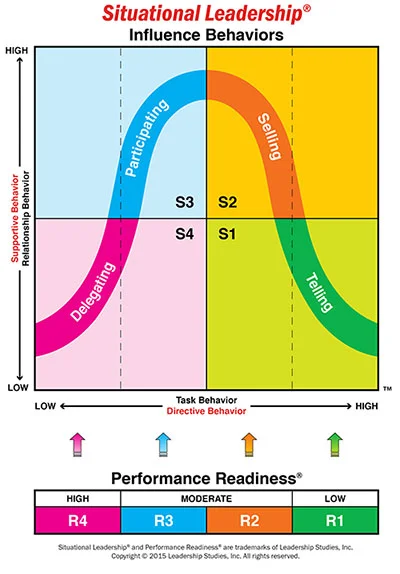5 Keys to Adopting a Situational Leadership Style
Effective leadership is not a one-size-fits-all approach. Different situations call for different leadership styles; what works for one team member may not work for another. Situational leadership provides you with the tools and strategies to navigate these varying situations and tailor your approach accordingly. In this blog, we will explore the concept of situational leadership in depth, understanding its essence and theory, discussing its advantages, identifying the four situational leadership styles, and addressing the challenges and solutions associated with its implementation. Whether you are an experienced leader or just beginning your leadership journey, adopting a situational leadership style can greatly enhance your effectiveness and your team’s success. So, let’s explore the five steps to adopting a situational leadership style.What is Situational Leadership?
Situational leadership is a theory developed by Paul Hersey and Ken Blanchard in their 1969 work, “Management of Organizational Behavior.” The theory proposes that effective leadership is not a fixed approach but rather an adaptive style that considers the given situation and the development level of the individuals being led. At its core, situational leadership recognizes that people are unique and vary in their abilities, motivation, and readiness to take on tasks. It emphasizes the importance of leaders adjusting their management style to meet the specific needs of their team members. The situational approach to leadership involves analyzing the situation and the individuals involved to determine the most effective leadership style. It requires you to consider factors such as the task at hand, the skill level and experience of the team members, and their level of motivation and confidence. Considering these factors, you can adapt your approach to provide the right direction and support.At the heart of situational leadership is the understanding that effective leadership is not a static concept but a dynamic process that adapts to the given situation. A situational leader recognizes that there is no one-size-fits-all approach to leadership and that different situations require different leadership styles.“Effective leaders need to be flexible, and must adapt themselves according to the situation.”
Paul Hersey and Kenneth Blanchard
What are the Advantages of Situational Leadership?
Situational leadership offers numerous advantages for both leaders and team members.- Effective leadership: Situational leadership allows you to adjust your approach based on the specific needs of your team members, leading to more effective leadership and improved outcomes.
- Flexibility: The situational leadership model allows you to adapt your style to different situations and team members’ needs, ensuring the best approach is used in each scenario.
- Management of organizational behavior: Situational leadership considers team members’ behavior and development levels, enabling you to manage and guide their behavior within the organization effectively.
- High level of performance: By tailoring your leadership style to the specific needs of your team members, you can foster a high level of performance and engagement, resulting in increased productivity and job satisfaction.
Identifying the 4 Situational Leadership Styles
In the situational leadership theory, four primary leadership styles correspond to different levels of team member readiness or maturity. These styles are:Directing
In the directing style, leaders provide clear instructions and closely monitor team members’ performance. They take a hands-on approach and provide specific guidance on how tasks should be done. The focus is on providing detailed directions and closely overseeing the work to ensure it is completed correctly. When should you use this? When team members are low-competent and low-committed.Imagine a new employee joining your team. Here, you should adopt a directing style by providing detailed instructions on how to use the company’s coding standards, software development tools, and project management system. Initially, you should closely supervise the new employee’s work, ensuring they understand the tasks and requirements. This style helps the new team members, who may have low competence and commitment initially, to grasp the basics and build confidence until they can contribute actively to your team.
Coaching
Coaching leadership is a situational leadership style that focuses on enhancing the competence of team members. It is most effective when working with individuals who have a certain level of knowledge and experience but still require support and guidance to improve their performance. In coaching, the leader takes on the role of a mentor or teacher, providing guidance and feedback to help team members develop their skills. When should you use this? This style is used when team members have low competence but high commitment.After a series of training sessions, you notice that one of your team members is struggling to execute a new marketing strategy. You can adopt a coaching style by regularly meeting with the team member to provide feedback, offer suggestions for improvement, and offer additional resources such as relevant articles or training modules. This approach helps the team member who demonstrates high commitment but lacks competence in the new strategy gradually develop their skills and confidence.
Supporting
Supporting leadership is a style that focuses on sharing responsibility and providing support to team members. It is best suited for individuals who have a high level of competence and are capable of handling their tasks independently. In supporting leadership, the leader empowers team members to make decisions and take ownership of their work. When should you use this? This style is used when team members have moderate to high competence but variable commitment.In a sales team where members have varying levels of experience, the team leader can employ a supporting style by acknowledging the diverse skill sets and motivations. The leader offers encouragement and praise to team members who are performing well while providing additional resources or assistance to those who may need it. This approach recognizes that team members have moderate to high competence but may differ in their level of commitment and thus need personalized support to maintain engagement and productivity.
Delegating
Delegating leadership is a style that empowers team members to take ownership and responsibility for their work. It is most effective when working with highly competent and motivated individuals who require minimal guidance and support. In delegating, the leader entrusts team members with decision-making and allows them to take the lead in their areas of expertise. When should you use this? This style is used when team members are highly competent and committed.In a mature project team with experienced members, the project manager adopts a delegating style by assigning specific tasks and responsibilities to each team member and allowing them to make decisions within their areas of expertise. The manager provides guidance when needed but trusts the team members to work autonomously and take ownership of their tasks. This approach leverages team members’ high competence and commitment to maximize efficiency and innovation while allowing them to contribute their unique skills and perspectives.
Challenges in Situational Leadership and How to Beat Them
Situational leadership comes with its own set of challenges. As you navigate different situations and adapt your leadership styles, you can encounter obstacles that require careful consideration and strategic solutions.Navigating Perceived Inconsistency
One challenge in situational leadership is navigating the perception of inconsistency among team members. Since situational leaders adapt their approach based on the needs of each situation, team members may perceive this as inconsistency or unpredictability. To address this, you should effectively communicate your reasoning behind the different leadership styles and ensure that team members understand the purpose and benefits of situational leadership. Open and transparent communication can help build trust and clarity and alleviate concerns about inconsistency in your approach toward team members, which can be further misunderstood as bias.Managing Complexity with Large Teams
Another challenge in situational leadership arises when you are leading large teams with diverse needs and complexities. Managing a large team requires careful consideration of individual team member’s needs and abilities, as well as balancing the overall goals and objectives of the team. To counter this, you should develop a management style that allows for effective communication, delegation of responsibilities, and collaboration among team members. You must also establish clear expectations and provide support and resources to ensure the team functions cohesively. Regular feedback and performance evaluations can help identify any issues or challenges within the team and allow for proactive solutions.How to Use Situational Leadership Style in Your Team?
Implementing situational leadership in your team requires a thoughtful and strategic approach. Here are two key steps to get started:Assessing Team Member Readiness
The first step in implementing situational leadership is assessing the readiness of your team members. It involves evaluating their skills, capabilities, and level of motivation. By understanding each team member’s development level, you can determine the appropriate leadership style to employ. You can do this through performance evaluations, feedback sessions, and open communication with your team members. It is important to regularly reassess team member readiness as their skills and abilities evolve.Matching Leadership Style to Development Level
Once you have assessed the readiness of your team members, the next step is to match the leadership style to their development level. It involves adapting your leadership approach based on their specific needs and capabilities. For team members who are new or inexperienced, a directing leadership style may be appropriate. As team members gain more competence and confidence, shifting towards a coaching or supporting leadership style may be more effective. Finally, delegating leadership can be employed for highly competent and self-motivated team members. It is important to regularly reassess the development level of your team members and adjust your leadership style accordingly.Developing Situational Awareness
Developing situational awareness is crucial for effective situational leadership. Situational leaders must be able to assess and understand each situation’s specific needs and dynamics. This requires developing emotional intelligence and the ability to empathize with others. By being aware of team members’ emotions, capabilities, and needs, you can adapt your approach and provide the necessary support and guidance.Factors You Should Consider
When transitioning to a situational leadership approach, there are several factors you should consider. These include:- the nature of the work
- the skills and capabilities of team members
- the specific goals and objectives of the team
- the overall organizational culture.
Qualities of Situational Leadership You Need
To successfully transition to a situational leadership approach, leaders need certain qualities. These include:- Empathy: Empathy is crucial for a situational leader as it enables you to understand and relate to your team members’ emotions, perspectives, and needs. Demonstrating empathy can build trust and rapport with your team, creating a supportive environment where individuals feel valued and understood.
- Adaptability: An adaptable leader can assess situations quickly, identify emerging challenges or opportunities, and adjust their leadership style accordingly.
- Decision-making: A leader who can make timely and well-informed decisions demonstrates confidence and clarity, instilling trust and confidence in their team members. By considering relevant information, weighing potential risks and benefits, and consulting with key stakeholders as needed, they make decisions that align with the team’s goals and values, driving progress.
- Delegation: Delegation is an important aspect of situational leadership as it allows a leader to leverage the skills and talents of their team members, empowering them to take on responsibilities and contribute to the team’s success.
- Guidance ability: Lastly, a situational leader’s guidance ability is essential for providing direction, support, and mentorship to their team members as they navigate challenges and pursue goals. A leader with solid guidance can offer clear expectations, constructive feedback, and actionable advice to help individuals develop their skills, overcome obstacles, and achieve their potential.
Conclusion
In essence, situational leadership involves adapting your leadership style to suit the specific needs of your team members. The key lies in assessing, adapting, and evolving your leadership style according to the ever-changing dynamics within your team. This flexibility and responsiveness will enhance team performance and foster a culture of growth and development. Embrace the situational leadership model to navigate challenges, maximize team potential, and achieve organizational goals.How strong are your delegation skills?
Assess your delegation skills for free with Risely’s free self assessment for managers.
Other Related Blogs



